Philippine Government Launches New War on Muslim Groups
Mobilize Workers’ Action to Defend Bangsamoro Peoples’ Struggle!
Drive Out All U.S. Imperialist Troops and Agencies!
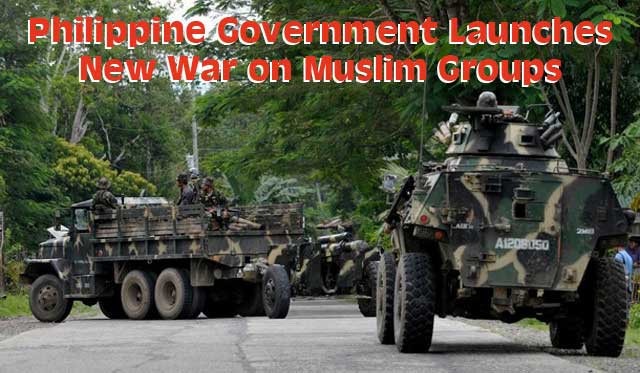 Philippine army artillery in North Cotabato province August 12 to drive Moro Islamic Liberation Front out of 22 villages it occupied after government cancelled autonomy agreement. (Photo: Jay Directo/AFP)
Philippine army artillery in North Cotabato province August 12 to drive Moro Islamic Liberation Front out of 22 villages it occupied after government cancelled autonomy agreement. (Photo: Jay Directo/AFP)
Build a Trotskyist Party in Philippines!
MANILA, Philippines, September 13 – War officially came to southern Philippines again as the government of Gloria Macapagal Arroyo dissolved the government peace panel, unilaterally putting an end to eleven years of negotiations with the Moro Islamic Liberation Front (MILF) September 3. Three days later, as AFP (Armed Forces of the Philippines) task forces launched sweeps searching for MILF units in Central Mindanao Region, rockets from a helicopter gunship killed fleeing civilians including two children and a pregnant newly wed teenager (Philippine Daily Inquirer, 9 September). While left-wing groups, opposition legislators and Muslim scholars denounced the government for calling off peace talks, reports came in of U.S. Special Forces soldiers accompanying AFP patrols. From a few hundred American soldiers in 2001, the number of U.S. troops in the Philippines grew to over 5,000 participating in the “Balikatan 2006” maneuvers on the southern island of Jolo. After the maneuvers were over, they never left. Congressional committees are investigating whether this violated the Visiting Forces Agreement.
Fighting already broke out last month when government officials suddenly refused to sign a Memorandum of Agreement on Ancestral Domain that had been negotiated with the MILF. The agreement was to have set up an autonomous regional “entity” in traditionally Bangsamoro areas1. The MOA was due to be signed at a ceremony on August 5, but at the last minute Arroyo called it off citing an injunction by her kept Supreme Court. What actually happened was that military hard-liners in the government negotiating team leaked the contents of the agreement to the press, touching off an uproar among Christian local officials in areas that were to be included in the Bangsamoro Judicial Entity (BJE), whereupon the high court issued its injunction. Angry commanders of the MILF’s military forces then proceeded to occupy areas which would have been included in the BJE, while right-wing local officials announced a “Reformed Ilaga Movement” to hunt down rebels. (The dreaded Ilaga vigilantes terrorized Muslims and left-wing activists during the dictatorship of Ferdinand Marcos.)
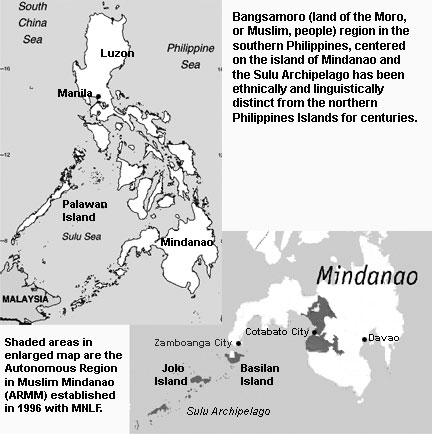 At least 100 people have been killed so far in the renewed fighting, hundreds more injured and 500,000 displaced from their homes as a result of clashes between AFP and MILF forces, as well as reciprocal burning of Christian and Muslim villages and communal massacres. While the press screams about MILF atrocities, it is the capitalist government of Gloria Macapagal Arroyo that is responsible for setting Filipino Christians and Muslims against each other. The AFP tops calculated on quickly wiping out the MILF forces, supposedly lulled into complaisance by eleven years of ceasefire, in order to then concentrate their forces against the guerrillas of the Communist-led New Peoples Army (NPA). Earlier, GMA and her militarist aides such as Eduardo Ermita and Norberto Gonzales had sought to use the Memorandum of Agreement to sneak through a “charter change” (“cha-cha”) in the Constitution, allowing her to stay in office after her present term (won through rampant election fraud) runs out in 2010. But now that they have run into resistance, all their plans have all gone up in the smoke of battle.
At least 100 people have been killed so far in the renewed fighting, hundreds more injured and 500,000 displaced from their homes as a result of clashes between AFP and MILF forces, as well as reciprocal burning of Christian and Muslim villages and communal massacres. While the press screams about MILF atrocities, it is the capitalist government of Gloria Macapagal Arroyo that is responsible for setting Filipino Christians and Muslims against each other. The AFP tops calculated on quickly wiping out the MILF forces, supposedly lulled into complaisance by eleven years of ceasefire, in order to then concentrate their forces against the guerrillas of the Communist-led New Peoples Army (NPA). Earlier, GMA and her militarist aides such as Eduardo Ermita and Norberto Gonzales had sought to use the Memorandum of Agreement to sneak through a “charter change” (“cha-cha”) in the Constitution, allowing her to stay in office after her present term (won through rampant election fraud) runs out in 2010. But now that they have run into resistance, all their plans have all gone up in the smoke of battle.
Bourgeois liberals and the petty-bourgeois left lamely call on the government to resume the “peace process,” which in any case was only intended to wear down the insurgents. (Talks with the NPA have been stalled since 2004.) But Arroyo announced that henceforth any negotiations will only be on the basis of “disarmament, demobilization and rehabilitation” (DDR) – in other words, abject surrender. As opposed to the reformist/liberal pipedreams of “peace,” revolutionaries would seek to mobilize Philippine workers to drive out all U.S. forces, whatever their legal status; to force the withdrawal of the AFP from the contested southern areas; and to defend the Bangsamoro people and their right to self-determination.
Colonization, Insurgency and Counterinsurgency
The island of Mindanao and the southern island chains of the Sulu Archipelago have been ethnically and linguistically distinct from Luzon and the northern islands for centuries. They were Islamicized in the 1400s under the sultanates of Sulu and Maguindanao. The region was never really conquered by the Spanish, who eventually recognized the independence of the sultan of Sulu. When the United States conquered the Philippines in the 1898 Spanish-American War, it carried out bloody massacres in the South, notably the first battle of Bud Dajo (1906) where up to 1,000 Moros were slaughtered by U.S. Marines in the crater of a volcano. (The Moro Massacre was made infamous by the Anti-Imperialist League in the U.S. and in particular by its vice-president, Mark Twain, who fought for Philippine independence.) As American colonial rulers established their authority over the next several decades, major U.S. corporations took over much of Mindanao, including Firestone (rubber); Dole, Del Monte and United Fruit (pineapples); and the timber and paper giants Weyerhauser and Boise Cascade. It was only with independence in 1946 that the region was formally integrated into the Philippines.
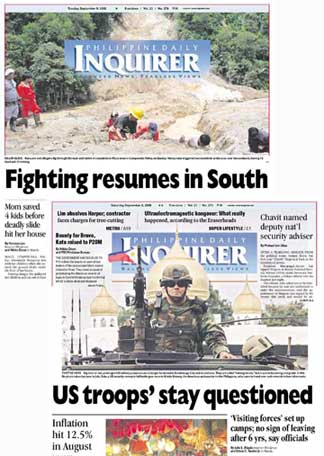 During the 1920s and ’30s, Christian settlers began moving into the region. In the 1950s, as part of its anti-Communist counterinsurgency program against the People’s Liberation Army (HMB), the government combined mass assassinations of “guerrilla suspects” with a “land reform” that sent peasants to militarized colonies in Mindanao. But the real surge in migration came later: “The movement speeded up dramatically under the Marcos regime – more than three million Christians are estimated to have settled in Mindanao between 1966 and 1976, Marcos’ first decade. The consequences have been devastating” (Ajiz Ahmad, “Class and Colony in Mindanao,” in Rebels, Warlords and Ulama: A Reader on Muslim Separatism and the War in Southern Philippines (Institute for Popular Democracy, 2000). By 1976, the Muslim population of Mindanao had fallen to 40 percent of the total, compared to 98 percent at the start of U.S. colonization, and Moros owned less than 17 percent of the land, mostly in remote infertile mountain areas. With the native population having become a minority due to colonization, the question of ancestral lands became a key issue.
During the 1920s and ’30s, Christian settlers began moving into the region. In the 1950s, as part of its anti-Communist counterinsurgency program against the People’s Liberation Army (HMB), the government combined mass assassinations of “guerrilla suspects” with a “land reform” that sent peasants to militarized colonies in Mindanao. But the real surge in migration came later: “The movement speeded up dramatically under the Marcos regime – more than three million Christians are estimated to have settled in Mindanao between 1966 and 1976, Marcos’ first decade. The consequences have been devastating” (Ajiz Ahmad, “Class and Colony in Mindanao,” in Rebels, Warlords and Ulama: A Reader on Muslim Separatism and the War in Southern Philippines (Institute for Popular Democracy, 2000). By 1976, the Muslim population of Mindanao had fallen to 40 percent of the total, compared to 98 percent at the start of U.S. colonization, and Moros owned less than 17 percent of the land, mostly in remote infertile mountain areas. With the native population having become a minority due to colonization, the question of ancestral lands became a key issue.
In the early 1970s, an insurgency arose in the Muslim population leading to the founding of the Moro National Liberation Front (MNLF). The Front received backing from the Organization of the Islamic Conference (OIC) and the Qaddafi regime in Libya. Initially landing blows against the AFP, the MNLF suffered military reverses as the government resorted to indiscriminate bombing, mass rape, burning of whole villages and massacres. When the OIC put pressure on for negotiations, a Tripoli Agreement was reached in 1976 for a southern autonomous region. But as the government dragged out negotiations and then called for a plebiscite in the 13 provinces affected (nine of which now had a Christian majority), talks collapsed. In 1984 the insurgency split and the Moro Islamic Liberation Front (MILF) was formed, more religious than ethnic nationalist in orientation, which argued that negotiations for autonomy were a trap and instead there must be armed struggle for independence. After a resurgence of guerrilla struggle in the early 1990s, the MNLF signed a Memorandum of Agreement in 1996 setting up an Autonomous Region in Muslim Mindanao (ARMM). MNLF chief Nur Misauri was elected governor.
With the MNLF leaders effectively bought off by the perks of office, the mantle of militant opposition passed to the MILF. But by 1997 the Islamic Front, too, was negotiating with Manila. In 2000-01, another splinter group surfaced, the shadowy Abu Sayyaf Group (ASG), originating in contacts with jihadi (holy war) groups from Indonesia to Afghanistan. Rather than a mass insurgency, the ASG specialized in kidnappings for ransom and indiscriminate terror against mass transportation and Christian communities. As part of their ongoing negotiations, the MILF reportedly coordinated with the government in isolating the ASG and driving it from its original base (International Crisis Group, “The Philippines: Counter-Insurgency vs. Counter-Terrorism in Mindanao,” May 2008). The MILF expected to be rewarded with control of the Bangsamoro Judicial Entity, covering much of the same area as the earlier Autonomous Region in Muslim Mindanao negotiated with the MNLF. But the generals evidently decided it no longer needed the services of either the MNLF or MILF. Beginning last year there were clashes between the AFP and units of both Moro fronts, and after months of back-and-forth, the negotiations came to an abrupt halt on August 4.
Under the Memorandum of Agreement on Ancestral Domain (MOA-AD) that had been initialed and was to be signed at a ceremony in Malaysia, the BJE would supposedly enjoy self government, as well as management of natural resources. In addition to the territory of the now moribund ARMM, the BJE would include other predominantly Muslim baranggays (districts) scattered around the islands. But when the MOA-AD was leaked, local officials launched protests and even liberal media in Manila objected to provisions allowing economic cooperation and trade relations with foreign countries (“Don’t Sign – Yet,” editorial in Philippines Daily Inquirer, 4 August). The Supreme Court issued its injunction against implementation of the agreement and ordered “further review” by the government. When several local MILF commanders decided to implement the MOA on their own, the government dispatched combined AFP units on “punitive actions” against the guerrillas and bombed MILF strongholds. In addition, it placed bounties on the heads of the rebel commanders, and handed out guns to the Ilaga vigilantes who are burning Muslim homes and fanning anti-Moro chauvinism in North Cotabato. The slaughter has begun.
For Permanent Revolution in Southeast Asia!
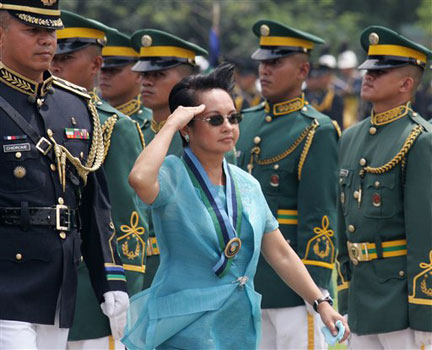 Strutting martinet Gloria Macapagal Arroyo reviews honor guard at change of command ceremony, May 12. Arroyo and her militarist clique seek to crush insurgents and prolong her regime. (Photo: Bullit Marquez/AP)
Strutting martinet Gloria Macapagal Arroyo reviews honor guard at change of command ceremony, May 12. Arroyo and her militarist clique seek to crush insurgents and prolong her regime. (Photo: Bullit Marquez/AP)
In justifying her policy of “disarmament, demobilization and rehabilitation” as henceforth the only basis for talks, the president said that she would not negotiate the MOA-AD “at gunpoint.” But that, of course, is exactly what she is proposing: to talk “peace” only under the guns of the AFP. The terms dictated by “General” Arroyo have never worked as a basis for a peaceful agreement between opposing armed groups, and how could they? “DDR” can only mean surrender and capitulation, which no insurgent group would do unless it was facing imminent defeat. The government’s real policy was summed up in its Oplan Bantay Laya (Operational Plan Freedom Watch), announced in January 2002 as part of the U.S. “global war on terror” (GWOT in the Pentagonese dialect). The aim of this “final solution” to rebellion was “to decisively defeat insurgents armed groups,” particularly the NPA, and to “degrade the military capability of the SPSGs” (Southern Philippines Secessionist Groups). For this it has received more than $4.6 billion in military aid from the U.S. Treasury.
According to a September 3 statement by Amirah Ali Lidasan, president of Suara Bangsamoro, the scrapping of negotiations with the MILF shows that the Arroyo regime was never serious about forging peace with the insurgents. So, too, does the fact that the terms of the MOA-AD were kept secret. GMA now seeks to end the decades-old rebellion of the Bangsamoro people by setting Christian settlers and Lumad hill tribes against the Moros. Noting that the Moros were forcibly evicted from their lands in endless military operations, SB points out: “The settlers and the Lumads in Mindanao lost their lands for these same reasons. We were made to fight over what was left of the land, ravaged by multinationals and landed elite.” Yet Suara Bangsamoro seeks to unite the different oppressed sectors on a (bourgeois) democratic basis, rather than a program of united class struggle. And it calls in vain for Arroyo to “keep the atmosphere of peace in Mindanao”! How likely is that?
Same theme from the MILF leadership, which countered by issuing statements that it has not abandoned peace talks and will continue to ask the Philippine government to comply with the Memorandum of Agreement on Ancestral Domains. The MILF added that it will wait for the formal notice from the Malaysian facilitators of the Philippines government’s unilateral decision to end the negotiations! Such impotent legalistic appeals will not stay the hand of a regime that is out for blood. Meanwhile, Representative Satur Ocampo of Bayan Muna (People First) party-list said he had long suspected that the government had no intention of signing the MOA-AD, and noted that DDR is the government's policy in the stalled “peace talks” with the National Democratic Front. Some left groups have launched protests against the war in Mindanao, calling for the immediate resumptions of peace talks. But all the efforts of the MILF and the NPA to negotiate and renegotiate seem doomed to fail: such talks cannot resolve the issues that have led to decades of rebellion throughout the Philippines.
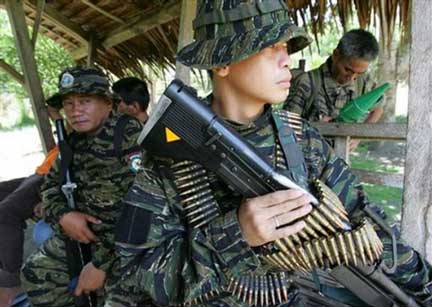 Rebel troops at MILF press conference in their Camp Darapanan in Maguindanao province, August 23. MILF leader Murad called on government to abandon military offensive. (Photo: Pat Roque/AP)
Rebel troops at MILF press conference in their Camp Darapanan in Maguindanao province, August 23. MILF leader Murad called on government to abandon military offensive. (Photo: Pat Roque/AP)
No bourgeois government in Manila will provide land to the impoverished peasantry or genuine autonomy to the myriad oppressed peoples of the archipelago. Such measures would mean the downfall of the government and a body blow to Philippine capitalism, which is based on superexploitation and heavy-handed repression. The policy of the GMA regime is no different than that of all the governments that preceded hers. When they “negotiate” it is only to wear down the rebellious insurgents, or to avoid being toppled by mass revolt. It is no accident that all the Philippine governments since “independence” have essentially been bonapartist, military-based regimes. Whoever sits in the president’s chair in Malacañang Palace – whether GMA or General Fidel Ramos, the “democrat” Cory Aquino or the dictator Ferdinand Marcos – it is the AFP that calls the shots on behalf of the Filipino capitalists and their Yankee imperialist overlords. Nor is this a peculiarity of the Philippines: it is a confirmation of Leon Trotsky’s theory and program of permanent revolution.
Basing himself on an analysis of the defeated Russian Revolution of 1905, and then the victorious October Revolution of 1917, Trotsky wrote that in the imperialist epoch the weak bourgeoisies in the countries of belated capitalist development (whether semi-feudal, colonial or semi-colonial) are incapable of realizing the tasks of the bourgeois revolution. Only the working class can achieve national liberation, agrarian revolution and democracy by seizing power at the head of the poor peasants and all the oppressed, under the leadership of a communist party, and then proceeding to undertake socialist measures while extending the revolution internationally to the imperialist centers. This program was diametrically opposed to the Stalinist-nationalist delusion of building “socialism in one country.” The illusory character of that anti-Marxist dogma was demonstrated by the collapse of the Soviet Union and the Stalinist-ruled, bureaucratically deformed workers states of East Europe. And it is tacitly confirmed by the Filipino Stalinists of the PCP, who today are not even fighting for a nationally limited revolution.
Trotskyists stand on the side of the NPA peasant guerrillas and the Bangsamoro insurgents against the murderous Philippine capitalist regime, but without supporting their reformist and bourgeois-nationalist politics. The “armed struggle” of Filipino Stalinists is in fact “armed reformism”: like the MNLF and MILF, the PCP/NPA and NDF want to use their military units as bargaining chips to negotiate their way into office. Their dream is not to replicate Stalin’s Russia or Mao’s China, but to imitate on a smaller scale their Nepalese comrades who are now administering the bourgeois state (and repressing Nepalese workers). Even if by some twist of fate they were to be moderately successful, it will not liberate the urban and rural working people or the oppressed Bangsamoro people but only shore up the capitalist status quo.
Mobilize Working-Class Action to Defend the Bangsamoro Peoples!
The League for the Fourth International, calls on the Filipino working class to unite – whether they are Christians, Muslims, Lumads or other indigenous peoples – and fight to sweep away the regime through revolutionary class struggle. Rallies for peace by various left-wing and cause-oriented groups will at most demonstrate their indignation, but cannot bring down or seriously shake the capitalist order. The reformists’ perspective is to form a popular front, tying the working class to the feeble bourgeois “opposition.” They would like to replicate the mass protests that ousted Marcos (with the permission of the U.S.) and installed Cory Aquino as a figurehead for AFP chiefs Ramos and Enrile – but they are far from even that. Meanwhile, Arroyo and her generals continue to deliver death blows to the Moro peoples and others who have taken up arms against the Filipino ruling class. On the other hand, mobilizing the Filipino workers in concrete actions against the war in the South, including strike action at key locations where possible, demanding withdrawal of the AFP and expulsion of the U.S. forces, could land a real blow on behalf of the beleaguered Bangsamoro population.
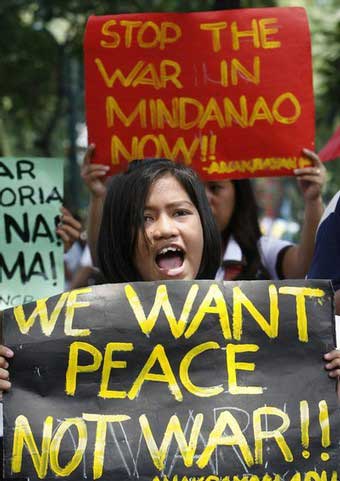 Student protest in Manila, August 14. Popular-front peace demos cannot bring down or even shake the capitalist order. It is necessary to mobilize the power of the working class against the war. (Photo: Romeo Ranoco/Reuters)
Student protest in Manila, August 14. Popular-front peace demos cannot bring down or even shake the capitalist order. It is necessary to mobilize the power of the working class against the war. (Photo: Romeo Ranoco/Reuters)
Today, working-class organizations in the Philippines are reeling. The unions are shadows of their former selves. A recent report by the Ecumenical Institute for Labor Education notes that in 1995 some 14.5 percent of the workforce was unionized, while today the official figure is 5.6 percent, and actual union contracts only cover 222,000 workers in the entire country (Bulatlat, 31 August). The vast majority of new hiring is for short-term contracts of a few months, and the official minimum wage (P382, or $8.50 a day) doesn’t even cover half the cost of basic expenses for a family of six (P894 or $19.50 a day in Metro Manila). So traditional business unionism, which seeks a stable role mediating between labor and capital, is moribund. Yet the potential power of the workers has not diminished. Tens of thousands of workers are concentrated in more than 50 special economic zones, harbors and central business districts. Class-struggle action to shut down industrial parks from Clark, Subic, Batanga and Cavite to Zamboanga and Davao; clogging the streets and bringing business in Makati to a standstill; pulling the plug on the call centers – all this is possible, but it requires a revolutionary, not a reformist leadership.
Even partial actions by the workers can show to the Moro peoples and other indigenous peoples of the Philippines that the Filipino working class supports their struggle for self-determination. Many leftists understand instinctively that the GMA regime will never grant genuine autonomy, much less independence to the Bangsamoro peoples. But they believe that somehow this can be won under a “democratic” capitalist regime. Thus the Cordillera People’s Democratic Front stated, in an August 25 declaration: “genuine autonomy can only be achieved within a truly free and democratic state, free from imperialist control, domestic feudalism, and bureaucrat capitalism.” But that can only come about under the rule of the working class – there is no non-bureaucratic capitalism or “national” bourgeoisie free of imperialist control. And while the Stalinist and social-democratic reformist left they may talk of self-determination, they call only for autonomy within the Philippines, never accepting the possibility of independence for Bangsamoro. Trotskyists recognize the right of independence for the Moro peoples while fighting for a socialist federation of Southeast Asia.
The League for the Fourth International along with comrades in the Philippines has called to “recognize the right of oppressed nationalities to independence (self-determination) from colonial-like rule of the bourgeois states of Indonesia and the Philippines” and for “defense of the insurgents and defeat of the military offensives against the Aceh, Moro, and Papuan peoples” while fighting for “equal rights of national and ethnic minorities under a revolutionary workers state” (see “The Class War in Southeast Asia,” The Internationalist No. 17, October-November 2003). Filipino Trotskyists fight for international proletarian revolution, and hail the action of U.S. dock workers who shut down West Coast ports on May Day. A struggle for workers action to sweep away George W. Bush’s puppet Arroyo will have an impact far beyond the Philippines.
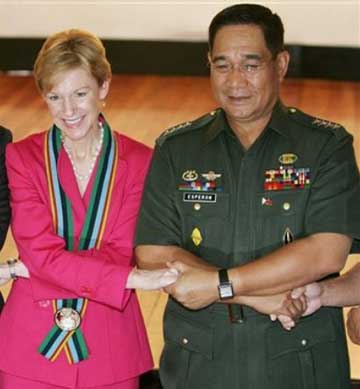 They aren’t singing Kumbaya. U.S. ambassador Kristie Kenney and then AFP chief Gen. Hermogenes Esperon at opening of Balikatan 2008 military exercises in February. (Photo: Bullitt Marques/AP)
They aren’t singing Kumbaya. U.S. ambassador Kristie Kenney and then AFP chief Gen. Hermogenes Esperon at opening of Balikatan 2008 military exercises in February. (Photo: Bullitt Marques/AP)
U.S. forces are certainly participating in the current AFP offensive, while all the while denying it. Despite the ban on foreign military bases in the Philippines constitution, U.S. Special Forces have a HQ at the Joint Special Operations Task Force-Philippines in the AFP’s Western Mindanao Command at Camp Navarro, in Zamboanga City (Business World, 12-13 September). But the U.S. also was intimately involved in the previous negotiations – so much so that some Filipino nationalists wondered if they were an American plot to take over Mindanao. The Center for People Empowerment in Governance notes that U.S. military had “direct access to the MILF including its military camps” through the Philippine Facilitation Project of the U.S. Institute of Peace. And it points out that the Memorandum of Agreement “binds the MILF to honor private landholdings, corporate plantations, foreign investments particularly in energy resources, as well as the presence of foreign forces in Bangsamoro” (Bulatlat, 31 August). Even right-wing senator Panfilo Lacson questioned the frequent visits of U.S. ambassador Kristie Kenney, who spends “out of 365 days at least 120 days in Mindanao” (Philippines Daily Inquirer, 9 September). Thus in explaining the abrupt shift in the government’s attitude on the peace negotiations with Moro insurgents, one has to consider the U.S. interest.
For one thing, there is ExxonMobil’s recent interest in exploring for oil in the Sulu Sea. Also, the Philippines was the fourth-largest recipient of U.S. military aid – after Israel, Egypt and Colombia – until it was recently surpassed by Georgia. It can hardly be coincidence that in the last six months, the U.S. client regimes in Colombia, Georgia and the Philippines have launched military attacks against local adversaries (Colombian attack on FARC guerrillas in March, a failed Georgian attack on Russian-backed Ossetia in early August, the Philippines military offensive against Moro areas in late August). Word has evidently gone out from the Pentagon and the White House to strike now, whether the aim is to distract attention from the morass in which the U.S. finds itself in Iraq and Afghanistan, to bolster the presidential chances of Republican “warrior” John McCain, or as a last gasp from the Bush-Cheney administration. A U.S./Israeli nuclear attack on Iran could be next. But in any case, action by the Filipino working class to thwart Arroyo’s military plans could throw a wrench into Washington’s war plans.
For the indigenous peoples’ struggle for self-determination and independence to lead them out of the terrible poverty and oppression to which capitalism has condemned them, the key is to build the nucleus of a genuine Filipino Leninist-Trotskyist party to fight for workers revolution in the Philippines and throughout Southeast Asia, in the struggle to reforge the Fourth International as the world party of socialist revolution. ■
1 Land of the Moro (Muslim in Spanish) people (Bangsa in Malay), the southern Philippines areas historically including the Sulu Archipelago, much of the large island of Mindanao, and Palawan (see map, above).
To contact the Internationalist Group and the League for the Fourth International, send e-mail to: internationalistgroup@msn.com
Get Involved
If you'd like to help with maintaining or developing the website, contact us.
Publish
Publish your stories and upcoming events on Indybay.


